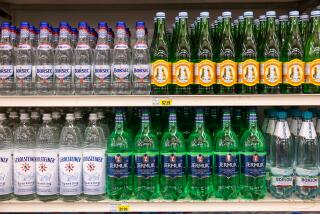Bottled Water: Not Getting Soaked
- Share via
NEW YORK — Even though many labels show beautiful mountain streams and cascading waterfalls, not all bottled waters are the same. Some may be little more than purified tap water.
The price of a bottled water may not indicate quality. Heavy bottles traveling long distances carry high shipping costs.
So check labels closely; they’ll provide clues to what’s inside.
There are 650 different brands of bottled water sold in Canada and the United States. Michele Asbar of Naya Beverages in Mirabel, Quebec, Canada, says some bottled waters are nothing more than treated tap water.
“As with other products in the food stores today, consumers need to understand the differences in bottled water and become alert label readers,” Asbar says.
When choosing a bottled water, look at the label. The line beneath the brand name tells you whether it’s natural, treated or distilled water.
Natural spring water must originate from a natural aquifer, or underground spring, with nothing added or taken away. It may be naturally carbonated, or still (non-carbonated).
Not all natural spring waters are the same. A major difference is the amount of dissolved minerals, or solids, they contain. The lower the dissolved mineral salts, the better the taste. However, you do want a small amount of minerals in the water or it will taste flat.
The container used to bottle natural spring waters can make a difference in taste. For reasons of breakage and shipping weight, most bottles of still water are plastic. Polyvinyl chloride (PVC) is the most common material, but using this material can mean the transfer of outside odors through to the water. Polyethylene terephthalate (PET) is a newer packaging material that does not allow foreign odors to penetrate.
Treated water is essentially tap water, with the harmful bacteria removed. Ozone and chlorine, among the most commonly used additives, are effective purifiers, but may leave a bitter aftertaste.
Distilled water is also known as demineralized and salt- and chemical-free water. Distilled water is tap water with the undesirable bacteria and the mineral content removed. This can be accomplished by charcoal filtration and deionization and, in some cases, carbonating the water. Distilled water can serve as drinking water, but the absence of minerals leaves a flat taste.
If you drink bottled water, don’t make ice cubes from tap water. “Cubes made from ordinary tap water can’t help but detract from the purity of bottled water, so chill bottled water, just as you would fine champagne,” Asbar says.


